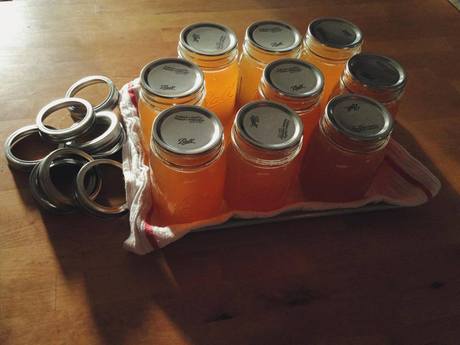Pressure canning and reality
Last night I taught the final class in a food preservation series with Whole Foods Market Austin, the topic: pressure canning stocks. Though I’ve taught this class numerous times (a couple times in Connecticut and once last year in Austin) my hopefulness that I could cram it into a 2-hour vs. 3-hour slot was dashed by pesky reality. As the class came to a close I wrapped up by bringing the canner to pressure so attendees could hear the weight-gauge’s steady rocking and then immediately turning it off. The pressure dropped just as the last attendees passed out of sight range from the classroom window, figures.
This misjudgement of time meant there were still unprocessed jars of stock in the canner that needed canning. I brought home the depressurized but still very hot canner (canning instructor living on the edge) and heard pinging lids and near catastrophic sloshing and jars-crashing-into-each-other noises as I drove home. [Now, don’t mistake pinging for safely canned. These jars didn’t get the 20 minute processing time (at 240 degrees) to make them safe for shelf storage. We can seal a jar easily via simple mechanics, but that has nothing to do with safety.]
After the wild ride home, I debated the merits of starting over (which is what I thought I should probably do)—dumping the stock out of the jars, reboiling the pot and putting it back into clean jars—or just leaving the jars in there and bringing the canner back to pressure and fully reprocessing (which is what I did). To my experimental delight, all 9 jars sealed after their second round of pressurization and processing.





 Wednesday, September 4, 2013 at 9:00AM
Wednesday, September 4, 2013 at 9:00AM

Reader Comments (4)
So, how do you know that they are all now sealed? I'm curious what your test is. I know some people say that if you can pick up the jar from the lid, then it's sealed...but then some people say that the 'ping' is what they go by, so...
Anyway, I'd love to hear how YOU "know"!
I've done both myself (although I usually feel a twinge of guilt when I "re-process" instead of starting over. I guess I figure that as long as I process for the correct time that I'm being "safe enough" (although a part of me swears there's no such thing as "safe enough.")
I usually do most of my canning late at night (I usually start around 8 or 9 pm) and depending on how many batches I have ready to process I've been known to just throw the last batch (or two or three) back into the fridge around 4 or 5 in the morning so I can bring it back up to a boil and finish processing the next day.
I've kicked myself any number of times for being overly cautious, usually at 5am when my bleary eyes are watching the sun rise through the kitchen window and I still have one last batch to process, but in the end the peace of mind more than makes up for it.
Surya,
After the jars have sat for 12 hours, I take off the bands and see if I can pry the lid off (without using fingernails, of course), if not they're sealed. Pings aren't a good measure because numerous factors can prevent you from hearing the ping (they're still in the pot then they seal, there's a pool of water on the lid, etc.)
Thanks for your honesty in this post! :-) Getting it done properly is important - no matter how tempted we are to cut corners, and no matter how experienced we are! Thanks for the helpful and candid post!